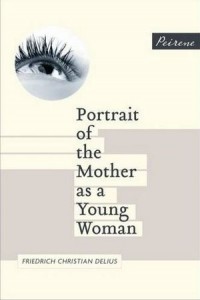Recent reads in brief
My lupus has been flaring, just a little, not enough to knock me out completely or even stop me reading completely, but enough to make my brain go blank when I try to write a review. So here are some short reviewettes of the books I’ve been reading.

Portrait of the Mother as a Young Woman
by Friedrich Christian Delius
translated from German by Jamie Bulloch
I had noticed for some time a growing number of glowing reviews for the books from Peirene Press, so earlier this year I ordered their Female Voice Series. This book is at once simple and highly experimental. A young German woman is living in Rome in 1943, waiting for her husband to return from the North African front. She is heavily pregnant and being cared for by nuns. The story follows her as she walks to a Bach concert at the Lutheran church and, once there, is transported by the music. That’s it. But it’s beautiful. Told in one long sentence, broken into paragraphs that work almost like the stanzas of a poem, her thoughts unreel. She ponders the sights of this foreign city, fear for her husband, faith in God, the contradictions of war and society in general, the possibilities of the future. She considers herself shy and uneducated but asks intelligent questions, questions she would only ever dare voice to her husband, if only he were there. A really excellent book and a great introduction to this new (to me) publisher.
“she sensed something within her rebelling against the constant obligation to stifle the feeling of longing with her reason and faith, because feelings were forbidden in wartime, you were not allowed to rejoice with happiness, you had to swallow your sadness, and like a soldier you were forced to conceal the language of the heart,”
Bildnis der mutter als junge frau published 2006 by Rowohlt.
This translation published 2010 by Peirene Press.
Source: I bought this direct from the publisher.
Challenges: This counts toward the 2013 Translation Challenge.
My Sister’s Keeper
by Jodi Picoult
This was a much better book than I expected. I thought it would be an easy, fluffy, light read. Well it was easy to read but certainly not the other two. It’s the story of a family whose second child, Kate, has a rare form of leukaemia. When her brother Jesse proves not to be a bone marrow match, the parents conceive another child, using IVF so that they can ensure a match this time. And so Anna is born. Every few years Kate’s leukaemia returns and Anna is again called upon to save her sister’s life. The story begins with 13-year-old Anna asking a lawyer to medically emancipate her from her parents, so that she won’t have to donate a kidney to her dying sister. Despite the emotionally charged background to the story, the book isn’t emotionally overwrought, in fact it’s often funny. But it thoughtfully considers all the options, all the situations this family has been through. Crucially they all have lives beyond this current drama, and the yo-yoing loyalties are absolutely believable. I was gripped and empathised with all the characters.
“This is not Anna. I am used to struggling with Jesse, to lightening Kate’s load; but Anna is our family’s constant. Anna comes in with a smile. Anna tells us about the robin she found with a broken wing and a blush on its cheek; or about the mother she saw at Wal-Mart with not one but two sets of twins. Anna gives us a backbeat, and seeing her sitting there unresponsive makes me realize that silence has a sound.”
Published 2004 by Simon & Schuster in the US, Hodder & Stoughton in the UK.
Source: I bought it secondhand.
Challenges: This counts towards the Rory Gilmore Reading Challenge.
The QI Book of the Dead
by John Lloyd and John Mitchinson
For those who don’t know, QI is a TV quiz show presented by Stephen Fry in which the celebrity teams have to come up with Quite Interesting answers. A whole raft of books have been published as an offshoot. This one is a series of vignettes about interesting dead people. They are grouped by topic (“Happy-go-lucky”, “Driven”, “Monkey keepers”, etc) and each person gets just 5–10 pages to have their life story told (and with more than 400 pages total that’s a lot of dead people). They’re a good mix of famous and not famous, though most were famous in their own lifetime. Often it’s the ones who have been forgotten with time that make the best reading. The book definitely lives up to its Quite Interesting label but it’s not one to read all at once. This perfectly suits dipping in and out of, reading 10 minutes at a time over a few months. The downside of this is that I’ve forgotten half the characters I swore I would look up to learn more about after John and John had whet my appetite.
“The establishment saw [Jeremy] Bentham as deeply dangerous. His ‘algebra of utility’ seemed to eat like an acid through centuries of accumulated privilege and injustice. He opposed slavery, and both capital and corporal punishment; he believed in equal rights for women, and for animals; he called for the decriminalising of homosexuality; he praised free trade and the freedom of the press; he supported the right to divorce and urged the separation of church and state. Most of what we now call liberalism can be traced back to Bentham.”
Published 2009 by Faber and Faber.
Source: A Christmas present from my brother a few years back.
Portrait of the Mother sounds really good. I hadn’t read of that press, but I’ll be looking out for them now. Happy reading!